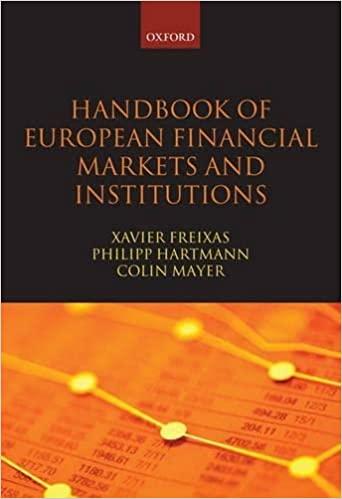Question
If someone invests $7,000 right now in an account that will pay 9% interest compounded annually, how much will they have in their account 2
-
If someone invests $7,000 right now in an account that will pay 9% interest compounded annually, how much will they have in their account 2 years from now? Answer in the following form: $#.## (with 2 decimals). DO NOT use a comma in your answer.
Selected Answer: [None Given]
Correct Answer: 8,316.70 ($)
Response Feedback: Future value of a lump sum
-
Question 2
0 out of 1 points
If a credit card company offered you a line of credit with a 13% APR (annual percentage rate), compounded daily, which of the following would be the effective annual rate? Use 365 days per year in the calculation.
Answer in the decimal format (e.g. 10.52% is 0.1052) with 4 decimals.
Selected Answer: 1
Correct Answer: 0.1388
Response Feedback: Effective annual rate (EAR)
-
Question 3
0 out of 1 points
If someone is guaranteed to receive $7,000 in 16 years and their discount rate is 7%, what should they be willing to accept now in exchange? That is, what should someone at least pay now for the guaranteed future cash receipt?
Answer in the following form: $#.## (with 2 decimals). DO NOT use a comma in your answer.
Selected Answer: 2
Correct Answer: 2,371.14 ($)
Response Feedback: Present value of a lump sum
-
Question 4
0 out of 1 points
Imagine you invest $4,000 right now in a stock that will pay 10% in dividends annually. Assuming you reinvest dividends and the price of the stock does not change, how much will your stock position be worth in 3 years from now? Answer in the following form: $#.## (with 2 decimals). DO NOT use a comma in your answer.
Selected Answer: 4
Correct Answer: 5,324.00 ($)
Response Feedback: Future value of a lump sum
-
Question 5
0 out of 1 points
Suppose someone offers you an investment that pays $200 at the end of each year for 9 years. If the expected rate of return is 2% compounded annually, what is the most you should be willing to pay today for that investment?
Answer in the following form: $#.## (with 2 decimals). DO NOT use a comma in your answer.
Selected Answer: 3
Correct Answer: 1,632.45 ($)
Response Feedback: Present value of an ordinary annuity
-
Question 6
0 out of 1 points
Suppose you invest $400 at the beginning of the each year, starting now and continuing for 15 years. If your rate of return is 7% compounded annually, what will the total value be 15 years from today?
Answer in the following form: $#.## (with 2 decimals). DO NOT use a comma in your answer.
Selected Answer: 2
Correct Answer: 10,755.22 ($)
Response Feedback: Future value of an annuity due
-
Question 7
0 out of 1 points
Suppose you own a preferred share of a company that will pay $6 each year forever. What should that share be worth today given a 11% required rate of return?
Answer in the following form: $#.## (with 2 decimals). DO NOT use a comma in your answer.
Selected Answer: 8
Correct Answer: 54.55 ($)
Response Feedback: Present value of a perpetuity
-
Question 8
0 out of 1 points
Given the following information, what should the current price of this bond be? Use the bond valuation model.
Face value: $1,000
Coupon rate: 12%
Yield to maturity: 9%
Years to maturity: 17
Assume interest is paid once per year and the next payment is a year from now.
Answer in the following form: $#.## (with 2 decimals). DO NOT use a comma in your answer.
Selected Answer: 5
Correct Answer: 1,256.31 ($)
Response Feedback: Standard bond valuation: Present value of an ordinary annuity of interest payments + Present value of the principal repayment at maturity
***Remember: the coupon rate determines the interest payment and the yield to maturity is our discount rate.
-
Question 9
0 out of 1 points
Given the following information, what should the current price of this bond be? Use the bond valuation model.
Face value: $1,000
Coupon rate: 14%
Yield to maturity: 11%
Years to maturity: 7
Assume interest is paid once per year and the next payment is a year from now.
Answer in the following form: $#.## (with 2 decimals). DO NOT use a comma in your answer.
Selected Answer: 2
Correct Answer: 1,141.37 ($)
Response Feedback: Standard bond valuation: Present value of an ordinary annuity of interest payments + Present value of the principal repayment at maturity
***Remember: the coupon rate determines the interest payment and the yield to maturity is our discount rate.
-
Question 10
0 out of 1 points
Given the following information, what should the current price of this stock be? Use the discounted dividend valuation model.
Type of equity: common stock
Current annual dividend: $7
Annual constant dividend growth: 4%
Required annual rate of return: 16%
Answer in the following form: $#.## (with 2 decimals). DO NOT use a comma in your answer.
Selected Answer: 0.2
Correct Answer: 60.67 ($)
Response Feedback: Present value of a growing perpetuity
Specific: Discounted Dividend Model for Common Stock
How do I calculate them to find the answers?
Step by Step Solution
There are 3 Steps involved in it
Step: 1

Get Instant Access to Expert-Tailored Solutions
See step-by-step solutions with expert insights and AI powered tools for academic success
Step: 2

Step: 3

Ace Your Homework with AI
Get the answers you need in no time with our AI-driven, step-by-step assistance
Get Started


